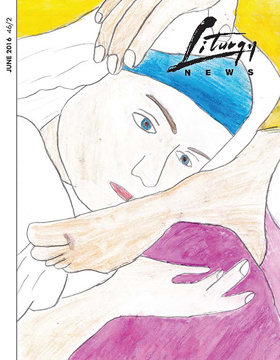Liturgy News
Vol 46 No 2 June 2016

Contents
| Title | Author | Topic | Page |
|---|---|---|---|
| Our Cover - Jesus and the Repentant Woman | - | Mercy | 1, 16 |
| Editor: A Million Madonnas | Elich, Tom | Art | 2 |
| Families Living God's Mercy - Preparing Children for the Sacrament of Penance | Hatherell, Kari, and Schwantes, Clare | Mercy | 3-4 |
| Liturgy: A Disciplined Rehearsal of Right Attitudes | Smith, Margaret | Liturgy | 5-6 |
| The Solemnity of Mary MacKillop | Pilcher, Carmel | Saints | 7 |
| Kimberley Diocese Jubilee 2016 - Photo Essay | - | Liturgical Inculturation | 8-10 |
| Magdalene Feast | - | Calendar | 11 |
| Guilford Young 100 | - | People | 11 |
| Women as Deacons | - | History of Liturgy / Vatican II | 11 |
| Reformation Day | - | Liturgy - Other Churches/Religions | 11 |
| ICEL Delegate | - | People | 11 |
| Pastoral Musicians | - | Music | 11 |
| Translations | - | Texts – Liturgical | 12 |
| Liturgical Architecture and Art Board | - | Architecture and Environment | 12 |
| Jerusalem Bible | - | Texts – Liturgical | 12 |
| ACU Centre for Liturgy | - | People | 12 |
| Romaldo Giurgola | - | In Memoriam | 12 |
| Evaluation of Mass Translation | - | Texts – Liturgical | 13 |
| WWW - Weally Worthwhile Websites | Harrington, Elizabeth | Technology | 13 |
| Renewing the Repertoire | Young, Anthony | Music | 14 |
| Books: Mass 101: Liturgy and Life by Emily Strand | Cronin, James | Eucharist / Mass | 15 |
Editorial
A MILLION MADONNAS
Elich, Tom
Recently I saw for the first time the statue of Our Lady of Sheshan. It is located at the National Shrine, the Basilica of Mary Help of Christians, in Shanghai, China. I discovered that it is a very special image for Chinese communities around the world. Commissioned in 2000, it shows the Virgin Mary holding the seated figure of the child Jesus aloft, high over her head. The child has outstretched arms as though embracing the world from the cross. I was deeply impressed.
With a million madonnas to choose from, how does a parish prepare an artist’s brief for the Mary shrine in their church? Of course, one could choose one of the standard images – Our Lady of Lourdes, Our Lady of Fatima, Mother of Perpetual Succour and so on. Sometimes one of these titles has a particular connection with the church or the community that worships there. But it is generally an uninspired choice to ask an artist to copy or even reinterpret one of these stereotyped images in modern style.
The first consideration for any church art (and especially devotional art) is that it is not primarily an expression of the artist’s creativity or individuality. Rather artistic talent is placed at the service of the church community and its faith. This issue needs to be tackled with some subtlety. Suitable art for churches is the result neither of a survey in the pews nor of straightjacketing the artist. It comes from dialogue and a relationship of mutual respect, from collaboration and a common understanding between artist and parish.
Theologically, devotion to the Virgin Mary always points to Christ. While honouring the Mother of God, [Marian] devotions cause her Son to be rightly known, loved and glorified, and all his commands observed (LG 66). Mary cooperates in the work of salvation by her fiat which gives the world its Saviour, Jesus the Christ. This right order is important for a parish shrine and has led some to advocate that Mary only be portrayed with the Christ child. This might be a sound generalisation but it admits of many exceptions. I think of the Mary Shrine commissioned for the Cathedral of St Stephen in the late 1980s. It represented Mary, Woman of Faith: it is the Virgin of the Annunciation and powerfully affirms the mystery of the incarnation and our recognition of human life from the first moment of conception.
This principle of showing Mary and Christ together however is itself not enough. The Virgin and Christ child have often been seen as a type of mother-and-child imagery. Here the tender and loving relationship between mother and infant takes centre stage. The figures look at each another and interact with each other in a way that can easily become sentimental. Many madonnas of the Italian Baroque are charming but theologically weak. This is Jesus showing us his mother.
The devotional shrine draws in those who come to pray and venerate the image. Through the image, Mary helps the faithful establish a new relationship with Christ. Mary, as the Vatican Council affirmed, is Mother of the Church, that is, just as she is mother of Christ so is she mother of the disciples who form the Body of Christ. The best Marian imagery for ecclesial devotion therefore has Mary presenting Christ to the people of God.
Romanesque madonnas often show a very formal Virgin – the Seat of Wisdom – with Christ on her lap facing the viewer. The famous Madonna del Parto by 16th century sculptor Jacopo Sansovino, found in the church of Sant’ Agostino in Rome, has the child holding a dove but standing on the Virgin’s lap, writhing and ready to leap forward. Or in Jacob Epstein’s 1953 madonna and child in London’s Cavendish Square the Christ child prefigures the entire mystery of Redemption accomplished on the cross. Then the triumphant Lady of Sheshan! This is Mary showing us her Son.
TOM ELICH
Editor
